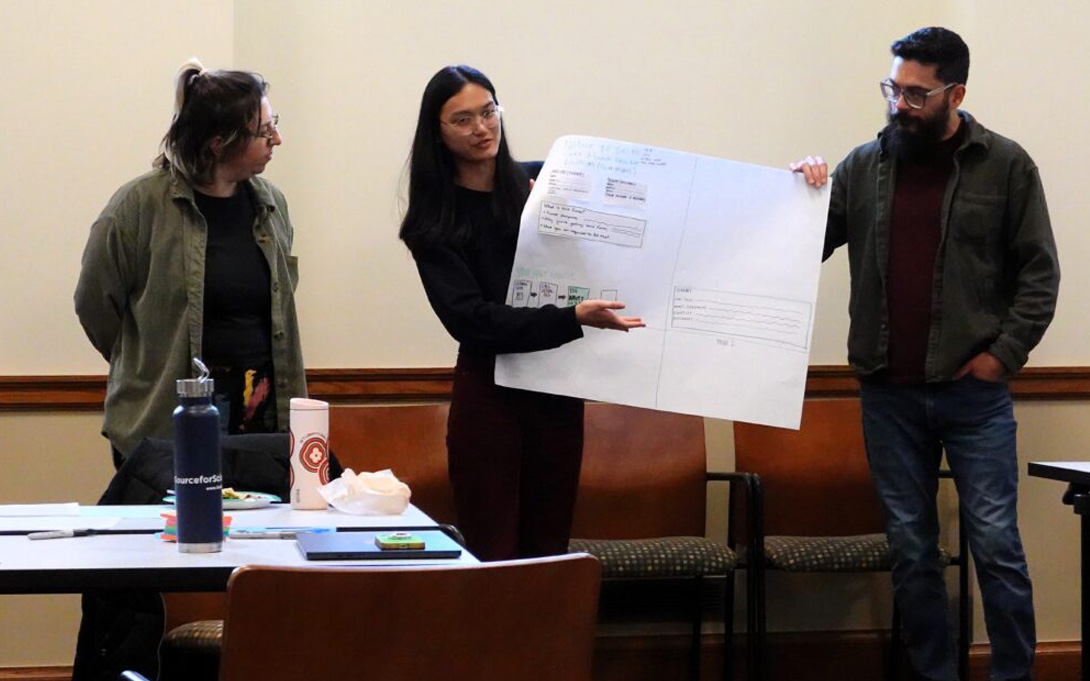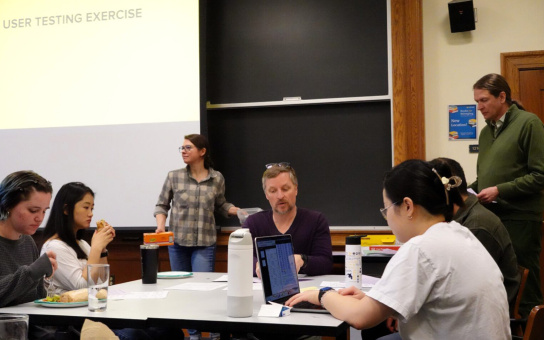
Eviction affects about 1 in 6 households in Michigan each year. Only 2% of tenants are represented by an attorney, placing the burden of understanding court processes and asserting legal rights on individual tenants.

To brainstorm ways of tackling the significant challenges Michigan residents face during the eviction process, a group of students, faculty, and legal professionals convened for a workshop dedicated to simplifying Michigan’s eviction court forms. Held at the Gerald R. Ford School of Public Policy on Friday, March 28, the Eviction Policy & Design Workshop was a continuation of a similar event conducted at the School of Information in November 2024. Participants engaged in human-centered design activities including user-testing and form design.
The workshop was spearheaded by Rachael Zuppke, a master’s student at the School of Information, and supported by Trevor Bechtel from U-M’s Poverty Solutions, Scott TenBrink from the School of Information, and Pamela Herd from the Ford School.
“This workshop was created in response to getting feedback from community members on eviction court forms,” Zuppke said. “While forms and service design are key pieces of how tenants learn about their case and court processes, an interdisciplinary approach that involves policymakers, administrators, and designers is needed to create meaningful impact for tenants. This workshop is a small step in demonstrating the ways policy and design can inform each other, and how that work can and should be centered on input from the communities they serve.”

Lauren Parker, a Master of Public Policy student, reflected on the workshop’s value.
“Attending the workshop provided an opportunity to think about and experience the implementation of a policy—a feature of policymaking that can be obscured by a focus on agenda setting and evaluation,” Parker said. “ Our discussions with faculty and students from other departments highlighted the differences in how problems are framed, with designers focusing on the end user (e.g., resident) and policymakers focusing on what’s politically and fiscally feasible. This collaborative space allowed us to think about bridging these perspectives.”
Zuppke drew inspiration from the research of Ford School faculty members Herd and Donald Moynihan, whose studies on administrative burden have explored the use of human-centered design methods to alleviate burdens in policy implementation.
Below, student Lucy Lawrence (MSW ‘25) writes about her experience participating in the Eviction Policy & Design Workshop.
I attended the Eviction Policy & Design Workshop held at the Ford School in collaboration with the School of Information and Poverty Solutions. The workshop’s purpose was to apply a human-centered approach to policy implementation. As a social work student, I participated alongside policy students and information students as we examined the design of eviction court forms.

We explored various types of forms that individuals receive during the eviction process. We focused on how people feel when interacting with these forms and discussed their experiences navigating the eviction process using them. We brainstormed potential changes to the design and content of these forms to improve the experience for those receiving an eviction notice or court summons.
As a social work student, I have often found myself in spaces where the people I am working with express to me the inaccessibility of legal documents. And it is then my job to advocate for more accessible, user-friendly documents. Even having been in these situations, it had never occurred to me exactly how the document could be better formatted to improve the experience of the client.
I learned in this workshop, this has much to do with UX, or user experience. In the design process, we considered how to use visual design to avoid unnecessary confusion and complications. We learned how putting too much information on a page can be overwhelming, and leaving white space can make a document more approachable.
Current legal documents in the eviction process, as we learned from an interview exercise, can make someone feel powerless. So how can we reformat information on the page, use a bold font, add translated text to empower the individual in this process, or at the very least make the process feel less overwhelming and threatening? It sounds simple, but we found ourselves struggling with where to start. There were certain aspects of the legal form that had to be in a certain spot, but created confusion for the person receiving the document. It was frustrating to work around these legal requirements that seemed to exist only for ease of filing, but we were able to creatively combat potential confusion through design.
In policy discussions, we often focus heavily on evaluation. We look at how programs and policies have worked, and at what ways they have not worked. While evaluating policy and program impact allows us to identify issues and areas that need improvement, we frequently do not dedicate enough time to developing solutions for these problems. We are more likely to see progress and achieve results when we come prepared with suggestions. Although we may not be the experts, we can still offer fresh perspectives, and by collaborating, we can create better solutions than we might have come up with individually. Overall, this workshop was an enjoyable experience that fostered collaboration across disciplines to enhance policy implementation and design.
>>Story written and published by Poverty Solutions
Photos by Lauren Slagter, Poverty Solutions

